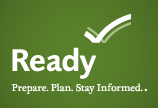Cleaning and Sanitizing with Bleach after an Emergency
Cleaning and sanitizing your household after an emergency is important to help prevent the spread of illness and disease.
Using Cleaning & Sanitizing Products
First, wash surfaces with soap and warm, clean water to remove dirt and debris. Next, sanitize surfaces with household bleach.
It is critical to read and follow the safety instructions on any product you use. Below are the most important safety guidelines when using sanitizing products:
- Never mix bleach with ammonia or any other cleaner.
- Wear rubber or other non-porous boots, gloves, and eye protection.
- Try not to breathe in product fumes. If using products indoors, open windows and doors to allow fresh air to enter.
Cleaning & Sanitizing with Bleach
Use regular unscented 5%—6% household bleach and follow the instructions in the chart below.
| Area or Item to be Cleaned | Amount of Bleach and Water to Mix | Cleaning Steps | |
|---|---|---|---|
| Bleach Amount | Water Amount | ||
|
Food surfaces that may have touched flood water. |
1 cup (240 milliliters) | 5 gallons (18.9 L) |
|
| Food cans that are not bulging, open, or damaged | 1 cup (240 mL) |
5 gallons (18.9 L) |
|
| Area or Item to be Cleaned | Amount of Bleach and Water to Mix | Cleaning Steps | |
|---|---|---|---|
| Bleach Amount | Water Amount | ||
|
Surfaces that do not soak up water and that may have touched floodwater. |
1 cup (240 mL) |
5 gallons (18.9 L) |
|
| Area or Item to be Cleaned | Amount of Bleach and Water to Mix | Cleaning Steps | |
|---|---|---|---|
| Bleach Amount | Water Amount | ||
|
Mold growth on hard surfaces. |
1 cup (240 mL) |
1 gallon (3.8 L) |
For more information see: |
Be aware that flood water may be contaminated. For more information about how to protect yourself and your family, visit Cleanup of Flood Water.
For more information on cleaning and sanitizing with bleach and how to make water safe for drinking, see Water Containers (Cleaning and Storage) and Make Drinking Water Safe.
- Page last reviewed: September 26, 2017
- Page last updated: October 10, 2017
- Content source:


 ShareCompartir
ShareCompartir

